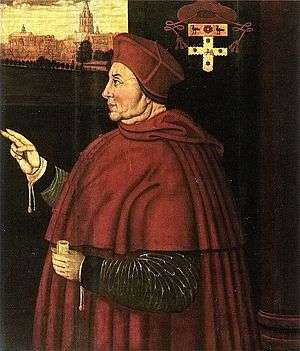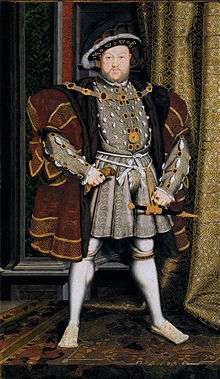Treaty of London (1518)

The Treaty of London in 1518 was a non-aggression pact between the major European nations. The signatories were Burgundy, France, England, the Holy Roman Empire, the Netherlands, the Papal States and Spain, all of whom agreed not to attack one another and to come to the aid of any that were under attack.[1]
The treaty was designed by Cardinal Wolsey and so came to be signed by the ambassadors of the nations concerned in London.[2] It was a response to the rising power of the Ottoman Empire which was encroaching into the Balkans. Wolsey was very keen on making lasting peace and persuaded Henry to avoid war and take a more diplomatic route in financial affairs.
Background
The ideal of lasting peace was especially advocated by Christian church officials throughout the centuries. During the Middle Ages, the church tried to advocate the idea of fighting the non-Christian world only, and to stop fighting between Christians. The Crusades were the focal-point for fighting against non-Christians. However, Christian identity waned during the Renaissance. After the fall of Constantinople in 1453, people in Europe began to identify primarily with Europe instead of Christianity. During the 15th century, peace was established for 50 years in the Italian Peninsula, which was divided into many small city-states. Only a small war between Venice and the Papacy for the control of Ferrara caused a temporary lapse in the peace. This peaceful period came to an end with the French invasion of 1494. A succession of small wars followed and in 1518 the political possibilities of a peace treaty seemed a realisation.
Terms

All European countries except for Islamic Turkey were invited to London (Russia was not considered to be a part of Europe, but of Asia at that time). The treaty hoped to bind the 20 leading states of Europe into peace with one another, and thus end warfare between the states of Europe. In October 1518 it was initiated between representatives from England and France. It was then ratified by other European nations and the Pope. The agreement established a defensive league based upon the following:
The terms committed states with an active foreign policy to not only commit to a stance of non-aggression, but also to promise to make war upon any state which broke the terms of the treaty. At the time, it was thought a triumph for Thomas Wolsey and allowed Henry VIII to greatly increase his standing in European political circles, to the extent that England became seen as a third major power.[3]
Legacy
There is some evidence that Wolsey viewed the treaty as a first step towards a greater integration between the states of Christian Europe, which arguably makes the treaty perhaps the first serious attempt at achieving European integration through diplomacy.
In any event, the peace the treaty brought lasted for a very short time. Wars broke out in a few years including wars between Denmark and Sweden, and between an alliance of England and Spain against France. The peace movement however continued for next centuries and became part of the Enlightenment movement in the 18th century.
References
- ↑ Tudor History. Treaty of London
- ↑ Henry VIII and Cardinal Wolsey, History at University of Wisconsin
- ↑ Europe and England in the sixteenth century by T. A. Morris, Routledge
See also
- List of treaties
- Treaties of London
- George of Poděbrady for an earlier proposal of similar nature